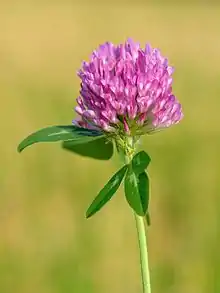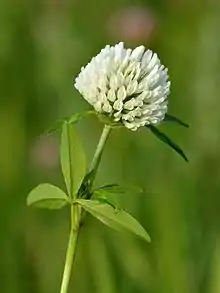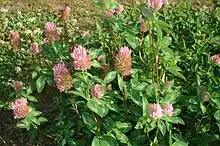Trifolium pratense
Trifolium pratense, red clover,[1][2] is a herbaceous species of flowering plant in the bean family Fabaceae, native to Europe, Western Asia, and northwest Africa, but planted and naturalized in many other regions.
| Trifolium pratense | |
|---|---|
 | |
| Scientific classification | |
| Kingdom: | Plantae |
| Clade: | Tracheophytes |
| Clade: | Angiosperms |
| Clade: | Eudicots |
| Clade: | Rosids |
| Order: | Fabales |
| Family: | Fabaceae |
| Subfamily: | Faboideae |
| Genus: | Trifolium |
| Species: | T. pratense |
| Binomial name | |
| Trifolium pratense | |
| Synonyms | |
| |
Taxonomy
Trifolium pratense was initially published by Carl Linnaeus in his book Species Plantarum on page 768 in 1753.
The genus has 3 known subspecies:[3]
- Trifolium pratense subsp. baeticum (Boiss.) Vicioso
- Trifolium pratense subsp. kotulae (Pawl.) Soják
- Trifolium pratense subsp. pratense
Description



Red clover is a herbaceous, short-lived perennial plant, which is generally variable in size, growing to 20–80 cm (8–31 in) tall. It has a deep taproot which makes it tolerant to drought and gives it a good soil structuring effect.[4] The leaves are alternate, trifoliate (with three leaflets), each leaflet 15–30 mm (0.6–1.2 in) long and 8–15 mm (0.3–0.6 in) broad, green with a characteristic pale crescent in the outer half of the leaf; the petiole is 1–4 cm (0.4–1.6 in) long, with two basal stipules that are abruptly narrowed to a bristle-like point. The flowers are dark pink with a paler base, 12–15 mm (0.5–0.6 in) long, produced in a dense inflorescence, and are mostly visited by bumblebees.[5]
Distribution
The red clover is native to Europe, Western Asia, and northwest Africa, but it has been naturalized in other continents, like North and South America. Specifically, the red clover was brought to Argentina and Chile over 100 years ago, although it is not clear how exactly it was introduced.[6] The red clover has become increasingly important as a source of economic stability in Chile, which has made the need for pollinators even more important.[7] One important pollinator, which was also brought from Europe, is Bombus ruderatus, or the large garden bumblebee. This bumblebee has been one of the important pollinators of red clover in South America and other countries such as New Zealand.[8] In India the highest producer of Red Clover seed is the Agriculture Department of Kashmir's Fodder Seed Production Station Aru, in south Kashmir's Anantnag district of Jammu & Kashmir.[9] Two red clover accessions were deposited in National Gene Bank of India from Fodder Seed Production Station Aru in 2019 vide IC-635999 and IC-636000 by ICAR.[10]
Uses

It is widely grown as a fodder crop, valued for its nitrogen fixation, which increases soil fertility. For these reasons, it is used as a green manure crop. Several cultivar groups have been selected for agricultural use, mostly derived from T. pratense var. sativum. It has become naturalised in many temperate areas, including the Americas and Australasia as an escape from cultivation.
Due to its beauty, it is used as an ornamental plant.
Red clover's flowers and leaves are edible, and can be added as garnishes to any dish.[11] They can be ground into a flour.
The flowers often are used to make jelly and tisanes, and are used in essiac recipes. Their essential oil may be extracted and its unique scent used in aromatherapy.
Trifolium pratense's perennial nature affords sustained, reliable growth. Furthermore, the species' ability to fix nitrogen promotes protein rich growth, enables it to support a wide range of wildlife including deer, turkeys, and rabbits. These characteristics make Trifolium pratense useful for hunters interested in attracting game. The pink flowers afford high visibility levels and facilitate such attraction and may be used by wildlife remediation teams and conservationists seeking to build wildlife bridges to connect fragmented habitats.[12]
Alternative and traditional medicine
In the traditional medicine of India, Trifolium pratense is believed to be a deobstruent, antispasmodic, expectorant, sedative, anti-inflammatory and antidermatosis agent.[13]
In alternative medicine, red clover is promoted as a treatment for a variety of human maladies, including symptoms of menopause, coughs, disorders of the lymphatic system and a variety of cancers. There is some evidence it may reduce the frequency of hot flushes in menopausal women.[14] There is no good evidence it is of any benefit in preventing or treating cancer or any other diseases.[15]
Due to its coumarin derivatives, T. pratense should be used with caution in individuals with coagulation disorders or currently undergoing anticoagulation therapy.[16] It is metabolised by CYP3A4 and therefore caution should be used when taking it with other drugs using this metabolic pathway.[17]
Diseases
Red clover is subject to bacterial as well as fungal diseases, including clover rot,[18] and red clover rust, Uromyces trifolii-repentis var. fallens. Other problems include parasitic nematodes (roundworms) and viruses.
Symbolism
Trifolium pratense is the national flower of Denmark[19] and the state flower of Vermont.[20]
References
- BSBI List 2007 (xls). Botanical Society of Britain and Ireland. Archived from the original (xls) on 2015-06-26. Retrieved 2014-10-17.
- USDA, NRCS (n.d.). "Trifolium pratense". The PLANTS Database (plants.usda.gov). Greensboro, North Carolina: National Plant Data Team. Retrieved 15 December 2015.
- "Trifolium pratense L." Retrieved 4 August 2023.
- "Red Clover". extension.psu.edu. Retrieved 2018-03-14.
- Van Der Kooi, C. J.; Pen, I.; Staal, M.; Stavenga, D. G.; Elzenga, J. T. M. (2015). "Competition for pollinators and intra-communal spectral dissimilarity of flowers". Plant Biology. 18 (1): 56–62. doi:10.1111/plb.12328. PMID 25754608.
- Rosso, B. S.; Pagano, E. M. (2005-08-01). "Evaluation of Introduced and Naturalised Populations of Red Clover(Trifolium pratense L.) at Pergamino EEA-INTA, Argentina". Genetic Resources and Crop Evolution. 52 (5): 507–511. doi:10.1007/s10722-005-0777-z. ISSN 0925-9864. S2CID 21172324.
- Arretz, P. V.; Macfarlane, R. P. (1986-01-01). "The Introduction of Bombus Ruderatus to Chile for Red Clover Pollination". Bee World. 67 (1): 15–22. doi:10.1080/0005772X.1986.11098855. ISSN 0005-772X.
- Morales, Carolina L; Arbetman, Marina P; Cameron, Sydney A; Aizen, Marcelo A (2013-07-15). "Rapid ecological replacement of a native bumble bee by invasive species". Frontiers in Ecology and the Environment. 11 (10): 529–534. doi:10.1890/120321. ISSN 1540-9295. S2CID 86469248.
- "Director Agriculture Kashmir Choudhary Mohammad Iqbal visited Aru, Pahalgam". Kashmir Mirror. 2022-02-20. Retrieved 2022-07-01.
- Mirror, Kashmir (October 17, 2021). "Director Agriculture Kashmir Inaugurates 41 varieties of high yielding Fodder Crops at Fodder Seed Production Farm Aru".
- "Red Clover: Pictures, Flowers, Leaves and Identification | Trifolium pratense". www.ediblewildfood.com. Retrieved 2019-02-15.
- "Wildlife Crossings". National Geographic Society. 2019-07-16. Retrieved 2021-01-22.
- Indian medicinal plants : an illustrated dictionary. Khare, C. P., 1932–. Berlin: Springer. 2007. ISBN 9780387706375. OCLC 316267725.
{{cite book}}: CS1 maint: others (link) - Ghazanfarpour M, Sadeghi R, Roudsari RL, Khorsand I, Khadivzadeh T, Muoio B (2016). "Red clover for treatment of hot flashes and menopausal symptoms: A systematic review and meta-analysis". J Obstet Gynaecol. 36 (3): 301–11. doi:10.3109/01443615.2015.1049249. PMID 26471215. S2CID 1987452.
- "Red Clover". American Cancer Society. November 2008. Archived from the original on 31 July 2014. Retrieved 22 September 2013.
- W. Abebe (2002). "Herbal medication: potential for adverse interactions with analgesic drugs". Journal of Clinical Pharmacy and Therapeutics. 27 (6): 391–401. doi:10.1046/j.1365-2710.2002.00444.x. PMID 12472978. S2CID 1828900.
- "Red clover (Trifolium pratense) Cautions – Epocrates Online". Online.epocrates.com. Retrieved 5 August 2012.
- Öhberg, H.; Bång, U. (2010). "Biological control of clover rot on red clover by Coniothyrium minitans under natural and controlled climatic conditions". Biocontrol Science and Technology. 20: 25–36. doi:10.1080/09583150903337805. S2CID 85239942.
- "Other National Symbols". Embassy of Denmark, Washington DC. Archived from the original on 17 May 2007. Retrieved 3 April 2015.
- "Red Clover". Vermont Historical Society. Retrieved 3 April 2015.
Further reading
- Vleugels, Tim; Roldan-Ruiz, Isabel; Cnops, Gerda (April 8, 2014). "Influence of flower and flowering characteristics on seed yield in diploid and tetraploid red clover". Plant Breeding. 134 (1): 56–61. doi:10.1111/pbr.12224. hdl:1854/LU-8508401.